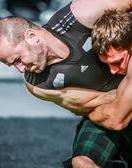In an ideal world (does one exist in the universe?) each player would have a professional strength and conditioning coach, who could teach him or her to perform Olympic Lifts and plyometrics safely and effectively.
Unless you’re a pro player, this isn’t going to happen. So you have two options remaining – do the exercises anyway, and risk injury, or just stick to the standard football player exercises of push ups, sit ups and running.
There’s another option, do these bad boy exercises listed below, for some speed gains and to mitigate the risk of injury.
Equipment Required:
- Resistance Band (long looped or with handles)
- Plastic 6kg kettlebell or mini resistance band
- A couch or sofa
- Stability ball
Disclaimer – exercise at your own risk
Resistance Band Thursters
When you run, you are extending and flexing your legs and your hips.
Olympic Lifts are used by professional athletes (usually) to develop explosive, quick and powerful hips and quads.
If you don’t have access to an Olympic bar, then resistance bands are just as good – arguably anyway. Some may say they are even better because of the “ascending strength” they develop (this relates to how the bands provide more resistance as they get lengthened)
A simple exercise routine to try for explosive hips is:
Resistance Band Thrusters x 6 reps
Followed by 4 vertical jumps
Try and do the thrusters (shown below) as quickly as possible, without a pause between the squat and the press
High Pulls either with a bar or a resistance band are also excellent and simple exercises to perform to increase hip extension power and speed.
Make sure you bend your legs, at the start of your high pull – most of the demos on YouTube just show upright rows, rather than proper Olympic Lift style high pulls.
Hip Flexor Strengthening
Running involves hip extension – and flexion.
A great way to strengthen the hips is also with a resistance band – but you’ll need to anchor the band at one end to someone or something and you’ll need an ankle strap.
A door anchor works great, just drive your knee up explosively like you’re an MMA or Thai boxing guy.
If you don’t have a resistance band, you can also use a ankle weight. I’ve also used a 6kg plastic kettlebell in the past – just stick your toes into the handle (at your own risk).
Tibilais Anterior Strengthening
The muscles in the front of your shin are important for deceleration changing direction and lifting your toes (dorsi flexion).
You can strengthen this muscle directly with a monkey foot which allows you to attach weights to your foot, using manual resistance (provide resistance using your hand), or, at your own risk, do what I do and stick your toes in the handle of a light plastic kettlebell.
Monkey Feet (the weightlifting kit, not the actual monkey’s feet) are expensive, instead you can use a TPE or latex mini resistance band to secure a dumbbell to your foot:
Hamstring Strengthening and Stretching
For speed and to mitigate the risk of injury, you will need to look at strengthening and lengthening your hamstrings.
Get warm, as warm as possible (I stretch my hamstrings in the bath) and hold your stretches for 30 seconds.
Add some dynamic and ballistic stretches too, again make sure you are warm – leg swings are simple and effective.
To strengthen your hamstrings, stability ball roll outs are great:
Nordic Hamstring Curls are also very effective, but pretty difficult and advanced. You can try them with a partner helping at first. I stick my feet under the sofa to do them.
Calf Strengthening and Stretching
Calf muscles are crucial when sprinting – they’re also susceptible to injury.
Foam roll and stretch them daily.
A simple way to improve calf strength is to hold onto something and perform single leg calf raises.
When you are warmed up, you can try these calf raises explosively/quickly on the upward phase of the movement
Arm Cadence
With a 2kg or 1kg set of dumbbells, practice the arm action involved in sprinting, as quickly as possible.
Try doing three, 20 second sprints, with 20 seconds rest in between sets.
Foot Cadence
There are many way to increase foot speed (or cadence), the easiest and most effective way that I have found is overspeed training.
Either run down a slight hill or decline – so you are forced to pick up your feet as quickly as possible
or
Use 2 resistance bands, or a bungee cord with either an anchor or a partner and have the cord or band pull your forwards to force you to increase speed. Be careful not to run into your partner or anchor point.
Training Programme
Three Times per Week, at Home:
- Nordic Curls or Hamstring Roll Outs on a Stability Ball – 3 sets of 10 reps
- Hip Flexor Strengthening – 3 sets of knees per leg – 6 reps (perform at speed)
- Resistance Bands High Pulls or Thrusters – 3 sets of 10 reps (perform at speed, with relatively light resistance)
- Single Leg Calf Raises – 2 sets of 8 reps – do first set slow and controlled and last 2 sets at speed
- Tibilias anterior strengthening 2 sets of 10 reps on each leg
Stretch:
- Hamstrings
- Hip Flexors
- Calves
Sprinting Session
Down hill overspeed sprints or resistance band sprints – 5 x 30m sprints with 1 min rest in between each sprint
Plyometric vertical jumps – 3 x 8
Bounds (I do these up the stairs at home) – 2 x 10

